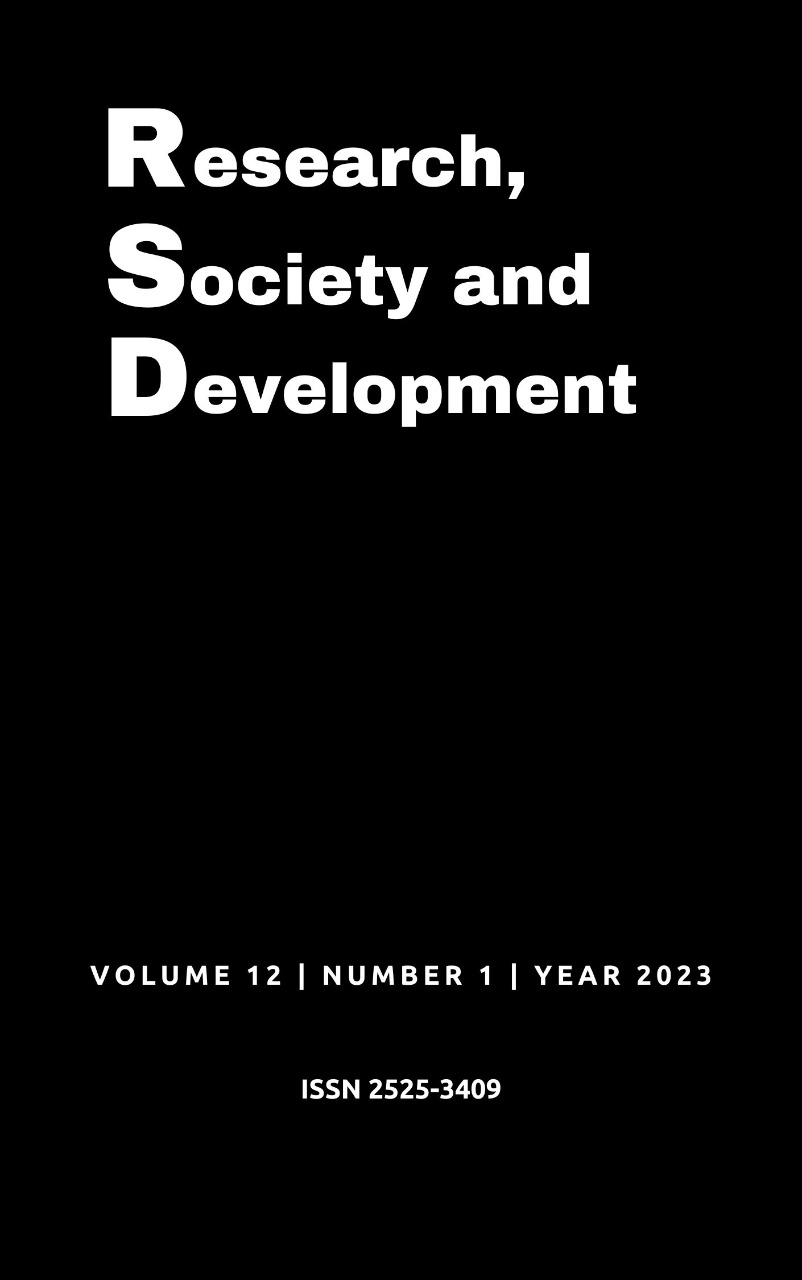O uso da musicoterapia como uma ferramenta terapêutica na área da saúde
DOI:
https://doi.org/10.33448/rsd-v12i1.39377Palavras-chave:
Musicoterapia, Qualidade de vida, Saúde.Resumo
Musicoterapia é a utilização da música e/ou elementos (som, ritmo, melodia e harmonia), em grupo ou de forma individualizada, num processo para facilitar, e promover a comunicação, relação, aprendizagem, mobilização, expressão, organização e outros objetos terapêuticos relevantes, no sentido de alcançar necessidades físicas, emocionais, mentais, sociais e cognitivas. O estudo tem como objetivo identificar os benefícios do uso da musicoterapia como ferramenta terapêutica na área da saúde. Trata-se de uma revisão integrativa da literatura, a qual as buscas foram realizadas nas bases de dados LILACS, SciELO e na MEDLINE, resultando em 193 artigos que após a leitura foram selecionados 15 artigos para compor a amostra final. Os estudos relatam que a musicoterapia traz efeitos positivos em cuidados paliativos, trazendo a diminuição da dor, dos níveis pressóricos, da frequência respiratória e cardíaca, ansiedade, e também na diminuição de sintomas depressivos e do consumo de ansiolíticos, bem como sensação de liberdade, da volta boas lembranças de casa e das suas famílias. Dessa forma, a musicoterapia pode ser uma intervenção não farmacológica eficaz para auxiliar no tratamento clínico no futuro cada vez mais amplo e utilizado, não só para pacientes em cuidados paliativos, com câncer e outras doenças que envolvem a internação, mas com qualquer outro estado de adoecimento para o alívio de sintomas.
Referências
Aleixo, M. A. R et al. (2022). Active music therapy in dementia: results from an open-label trial. Jornal Brasileiro de Psiquiatria.
https://www.scielo.br/j/jbpsiq/a/BsCKR6BvK7d4pNKhrCKtWhx/?lang=en
Atkinson, T. M. et al. (2020). Association between music therapy techniques and patient-reported moderate to severe fatigue in hospitalized adults with cancer. JCO Oncology Practice. 16(12), e1553-e1557. https://www.ncbi.nlm.nih.gov/pmc/articles/PMC7735038/
Brasil. (2017). Portaria Nº 849, de 27 de março de 2017. Inclui a Arteterapia, Ayurveda, Biodança, Dança Circular, Meditação, Musicoterapia, Naturopatia, Osteopatia, Quiropraxia, Reflexoterapia, Reiki, Shantala, Terapia Comunitária Integrativa e Yoga à Política Nacional de Práticas Integrativas e Complementares.
Bardin, L. (2011). Análise de conteúdo. Edições 70. 280 p.
Dahms, R. et al. (2021). Influence of music therapy and music-based interventions on dementia: A pilot study. Journal of Music Therapy. 58(3), e12-e36. https://academic.oup.com/jmt/article/58/3/e12/6265007?login=false
Daengruan, P. et al. (2021). Eficácia da musicoterapia receptiva com batidas binaurais de 10 Hz incorporadas em comparação com o tratamento padrão para pacientes com transtorno depressivo maior: um estudo controlado randomizado. Terapias Complementares em Medicina. 61(1). https://doi.org/10.1016/j.ctim.2021.102765
Franco, J. H. M. et al. (2021). A musicoterapia em oncologia: percepções de crianças e adolescentes em cuidados paliativos. Escola Anna Nery. 25(5), e20210012.http://www.revenf.bvs.br/scielo.php?script=sci_arttext&pid=S1414-81452021000600202
Hagemann, P.M.S, Martin, L.C & Neme, C.M.B. (2018). The effect of music therapy on hemodialysis patients' quality of life and depression symptoms. Brazilian Journal of Nephrology. 41, e74-e82. https://www.scielo.br/j/jbn/a/Cw88RbPRTmsHCbKntzHxK9v/?lang=en
Li, Xiuting et al. (2020). Music intervention improves the physical and mental status for patients with breast cancer: A protocol of randomized controlled trial. Medicine. 99(49). https://www.ncbi.nlm.nih.gov/pmc/articles/PMC7717794/
Liu, H., Gao, X. & Hou, Y. (2019). Effects of mindfulness-based stress reduction combined with music therapy on pain, anxiety, and sleep quality in patients with osteosarcoma. Brazilian Journal of Psychiatry. 41, e540-e545. https://www.scielo.br/j/rbp/a/d7QGKhXQtB9ssd3sWVz3Lrf/?lang=en#
Lima, T. U., et al. (2020). Impact of a music intervention on quality of life in breast cancer patients undergoing chemotherapy: a randomized clinical trial. Integrative Cancer Therapies, 19, e1534735420938430, 2020. https://www.ncbi.nlm.nih.gov/pmc/articles/PMC7491226/
Lin, Z.-W. et al. (2021). The effect of music therapy on chronic pain, quality of life and quality of sleep in adolescents after transthoracic occlusion of ventricular septal defect. The Heart Surgery Forum. 24(2), e305–e310. https://journal.hsforum.com/index.php/HSF/article/view/3513
Lund, H. N et al. (2020). Music to improve sleep quality in adults with depression-related insomnia (MUSTAFI): study protocol for a randomized controlled trial. Trials. 21(1), e1-e10. https://www.ncbi.nlm.nih.gov/pmc/articles/PMC7118840/
Oliveira, M. F et al. (2014). Musicoterapia como ferramenta terapêutica no setor da saúde: uma revisão sistemática. Revista da Universidade Vale do Rio Verde, Três Corações. 12(2), e871-e878.
Pommeret, S. et al. (2019). Music in palliative care: a qualitative study with patients suffering from cancer. BMC palliative care. 18(1), e1-e6. https://bmcpalliatcare.biomedcentral.com/articles/10.1186/s12904-019-0461-2
Peng, C. S., Baxter, K & Lally, K. M. (2018). Music Intervention as a Tool in Improving Patient Experience in Palliative Care. American Journal of Hospice and Palliative Medicine®. 36(1), e45–e49. https://journals.sagepub.com/doi/10.1177/1049909118788643
Uggla, L. et al. (2018). Music therapy supported the health-related quality of life for children undergoing haematopoietic stem cell transplants. Acta Paediatrica. 107(11), e1986–e1994. https://onlinelibrary.wiley.com/doi/10.1111/apa.14515
UBAM. União Brasileira das Associações de Musicoterapia. Ubam, 2016. https://ubammusicoterapia.com.br/wp-content/uploads/2018/08/musicoterapia-no-SUS.pdf Acesso em: 26 nov. 2022.
Warth, M. et al. (2021). “Song of Life”: Results of a multicenter randomized trial on the effects of biographical music therapy in palliative care. Palliative medicine. 35(6), e1126-e1136. https://www.ncbi.nlm.nih.gov/pmc/articles/PMC8188998/
Xu, C., et al. (2022). Potential benefits of music therapy on stroke rehabilitation. Oxidative Medicine and Cellular Longevity. 2022. https://www.ncbi.nlm.nih.gov/pmc/articles/PMC9217607/
Downloads
Publicado
Edição
Seção
Licença
Copyright (c) 2023 Ana Júlia da Silva Nogueira; Marya Karolinny de Lima Silva; Clésia Oliveira Pachú

Este trabalho está licenciado sob uma licença Creative Commons Attribution 4.0 International License.
Autores que publicam nesta revista concordam com os seguintes termos:
1) Autores mantém os direitos autorais e concedem à revista o direito de primeira publicação, com o trabalho simultaneamente licenciado sob a Licença Creative Commons Attribution que permite o compartilhamento do trabalho com reconhecimento da autoria e publicação inicial nesta revista.
2) Autores têm autorização para assumir contratos adicionais separadamente, para distribuição não-exclusiva da versão do trabalho publicada nesta revista (ex.: publicar em repositório institucional ou como capítulo de livro), com reconhecimento de autoria e publicação inicial nesta revista.
3) Autores têm permissão e são estimulados a publicar e distribuir seu trabalho online (ex.: em repositórios institucionais ou na sua página pessoal) a qualquer ponto antes ou durante o processo editorial, já que isso pode gerar alterações produtivas, bem como aumentar o impacto e a citação do trabalho publicado.


